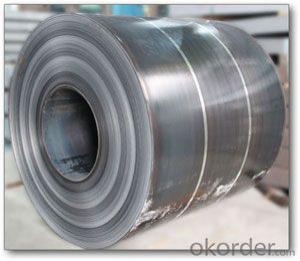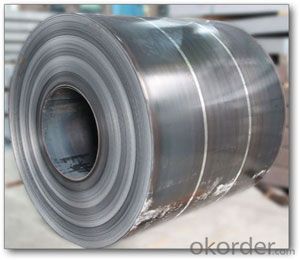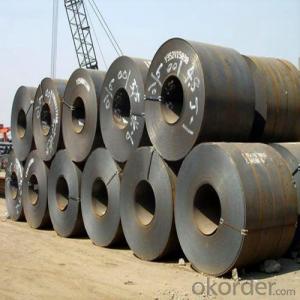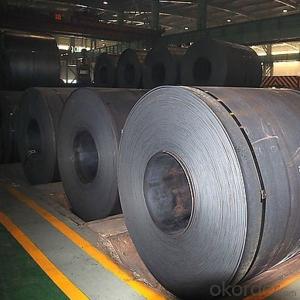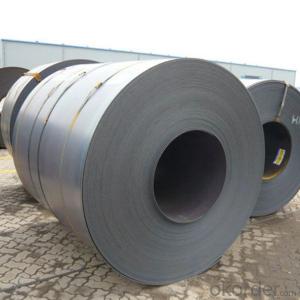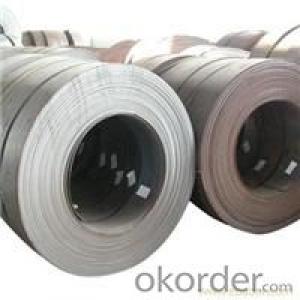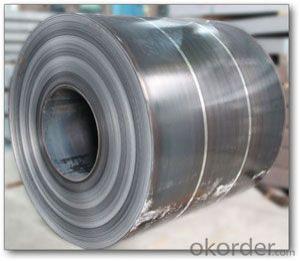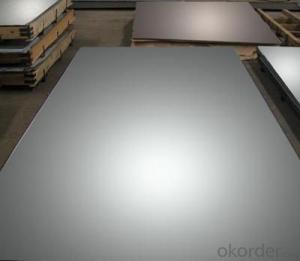BEST HOT ROLLED STEEL COIL HIGH QUALITY AND COMPETITVE PRICE
- Loading Port:
- Tianjin
- Payment Terms:
- TT OR LC
- Min Order Qty:
- 100 m.t.
- Supply Capability:
- 8000 m.t./month
OKorder Service Pledge
OKorder Financial Service
You Might Also Like
HOT-ROLLED STEEL COIL
Hot rolled low hardness, easy processing, good ductility.
Available specification:
thickness | width(mm) | length(mm) | coil inside diameter(mm) | |
HOT ROLLED STEEL COIL | 1.5-25 | 600-2000 | 762 | |
HOT ROLLED STEEL STRIP | 1.5-20 | 30-720 | 762 | |
HOT ROLLED STEEL PLATE | 6-700 | 500-4500 | 4000-18000 | |
HOT ROLLED STEELSHEET | 1.2-25 | 50-2000 | 0-18000 |
We can supply customers' with different specifications of the highest quality and lowest price.
Sincerely welcome to contact us for the future details if any item interest you ,and we will make every effort to assure that your requirements will be satisfied ,and we hope to establish long-term business relations with you on the basis of the equality and mutual benefit.
We are waiting for your email.
- Q: How are steel coils processed and shaped into specific products?
- Steel coils are processed and shaped into specific products through a series of manufacturing steps. Initially, the coils are uncoiled and straightened to remove any bends or twists. Then, the steel is cut into desired lengths using shearing or slitting techniques. Next, the cut steel is shaped and formed through processes like rolling, bending, or stamping to achieve the desired shape. Additional operations such as welding, machining, or surface treatments may also be performed. Lastly, the finished products are inspected for quality and packaged for distribution.
- Q: I just purchased this Benchmade knife with m390 steel blade and it cost me a fortune but I wanted to know if this new steel is a tool steel. what classifies a tool steel. M390 = 1.9 carbon, 20. chromium, .30 manganese, 1. molybdenum, .60silicon, .60 tugsten, 4. vanadium at 60-62 HRC
- Congratulations you can read a table of steels. Yes M390 is a tool steel. Blades is one application as is the manufacture of injection moulding tools.
- Q: How are steel coils used in the production of steel containers?
- Steel coils are an essential component in the production of steel containers. These coils, made from flat-rolled steel, are used to create the main body of the container. Firstly, the steel coils are unwound and fed into a rolling mill, where they undergo a series of processes to shape and form the steel. This includes heating the coils to a specific temperature to make them more malleable and easier to work with. The hot coils are then passed through a series of rollers that gradually reduce their thickness and lengthen them to the desired size. This process is known as hot rolling. Once the steel coils have been rolled to the required thickness, they are then cooled and cut into sheets. These sheets are then further processed to remove any imperfections or irregularities, ensuring a smooth and uniform surface. This is done through processes such as pickling, where the sheets are treated with acid to remove any scale or rust, and cold rolling, where the sheets are passed through rollers at room temperature to achieve the desired thickness and surface finish. After the sheets have been cleaned and smoothed, they are then formed into the shape of the container. This is typically done through a process called stamping, where the steel sheets are pressed into a mold using a hydraulic press. The mold determines the shape and size of the container, and the steel sheets are pressed against it with immense force, resulting in the desired container shape. Once the containers have been formed, they undergo various finishing processes such as welding, painting, and coating to enhance their durability, appearance, and resistance to corrosion. These final touches ensure that the steel containers are of high quality and meet the required standards for their intended use. In summary, steel coils play a crucial role in the production of steel containers by providing the raw material from which the containers are formed. Through a series of processes, the steel coils are shaped, cut, and formed into sheets, which are then further processed and transformed into the desired container shape. The result is a durable and reliable steel container that can be used for various applications across industries.
- Q: What are the common coil lengths available for steel coils?
- The common coil lengths available for steel coils vary depending on the industry and specific requirements. However, some standard coil lengths are commonly used across various applications. These include coil lengths of 100 feet (30.48 meters), 200 feet (60.96 meters), 300 feet (91.44 meters), and 500 feet (152.4 meters). These lengths are often used in industries such as construction, manufacturing, and automotive, where steel coils are widely used for various purposes. It is important to note that coil lengths can also be customized based on specific project needs or customer preferences.
- Q: I have my grandpa's navy knife from ww2, a mk2 combat knife i think, and i was wondering what type of steel it is made of. I'm guessing it's a high carbon steel, i'd just like to know exactly what grade.
- 1095 Steel - Easy to sharpen, plain carbon steel used in knife making. Proven to be one of the most popular steels used in KA-BAR knives. Right from the OEM site. Worked for a company that started in 1859 as a safe manufacturer. The steel recipes have not changed much from WWII (when Elliot Ness was running the company) to now. Doubt the KA-BAR recipes has changed either.
- Q: What are the safety precautions to be followed while handling steel coils?
- When handling steel coils, there are several safety precautions that should be followed. These include wearing appropriate personal protective equipment, such as gloves and safety glasses, to protect against cuts, abrasions, and eye injuries. It is important to use proper lifting techniques and equipment to prevent strains or back injuries. Steel coils should be securely stacked and stored to prevent them from falling or rolling, and caution should be exercised when moving or transporting them to avoid accidents. Additionally, workers should be trained on the safe handling and storage procedures specific to steel coils to minimize any potential hazards.
- Q: For example, (and this is weird) if I were wearing a steel collar and I needed some way to remove it, with limited supplies.Force is difficult because it would be around my neck.Chemical cominations are great- but they have to use VERY common products. And I'm not sure what to use.Other ideas?
- Your best bet would be a grinding wheel attached to a small electric motor. Even if you slipped, your skin is too soft to be cut by the dull wheel. Steel, however, is easily cut. But perhaps you don't have access to electricity or pressurized air to run such a tool. In that case, a simple file would work well, though you'd be somewhat more likely to injure yourself. If you had no tools, but access to whatever chemicals you wanted, you could try a weak acid. This would take a long time, and require constant scrubbing to bring fresh acid into the pits in the metal, but it would eventually eat through the collar.
- Q: What are the different types of steel coil packaging systems?
- There are several types of steel coil packaging systems available, including horizontal coil packaging machines, vertical coil packaging machines, and coil wrapping machines. Each system is designed to securely package steel coils for transportation and storage, ensuring their protection from damage and corrosion.
- Q: How are steel coils inspected for flatness?
- Steel coils are inspected for flatness using various methods, such as visual inspection, measuring the crown or center buckle, and conducting a straight edge test. These techniques help assess any deviations or unevenness in the coil's surface, ensuring that it meets the required flatness standards.
- Q: What are the different methods of skin pass rolling for steel coils?
- Steel coils can undergo skin pass rolling using various methods, each possessing its own distinctive characteristics and advantages. Some commonly employed techniques include: 1. Dry Skin Pass: This method entails passing the steel coil through rolls without applying any lubricant or coolant. The absence of these substances aids in enhancing the steel's surface finish by minimizing thickness fluctuations and achieving a smoother texture. 2. Wet Skin Pass: This approach involves utilizing a water-based emulsion or coolant during the skin pass rolling procedure. The coolant serves to decrease friction and heat generated during rolling, resulting in improved surface quality and reduced risk of surface defects. 3. Electrolytic Skin Pass: This technique utilizes an electrolytic solution during skin pass rolling. The steel coil is submerged in the solution, and an electric current is applied to the coil, leading to controlled surface etching. This method is particularly effective in improving surface cleanliness and eliminating oxide scale. 4. Temper Mill Skin Pass: This method combines skin pass rolling with a tempering process. The steel coil undergoes a series of rolls, followed by a heating and cooling process to achieve the desired mechanical properties and surface finish. This method is commonly employed for high-strength and automotive-grade steel coils. 5. Tension Leveling: In this method, the steel coil is passed through a series of rolls while under high tension. This elongates the steel, reducing residual stresses and shape defects, thereby enhancing flatness and dimensional stability. It is important to note that the selection of a skin pass rolling method depends on factors such as the desired surface finish, required mechanical properties, and the type of steel being processed. Each method offers its own advantages and limitations, and manufacturers typically choose the most suitable approach based on their specific needs.
Send your message to us
BEST HOT ROLLED STEEL COIL HIGH QUALITY AND COMPETITVE PRICE
- Loading Port:
- Tianjin
- Payment Terms:
- TT OR LC
- Min Order Qty:
- 100 m.t.
- Supply Capability:
- 8000 m.t./month
OKorder Service Pledge
OKorder Financial Service
Similar products
Hot products
Hot Searches
Related keywords
